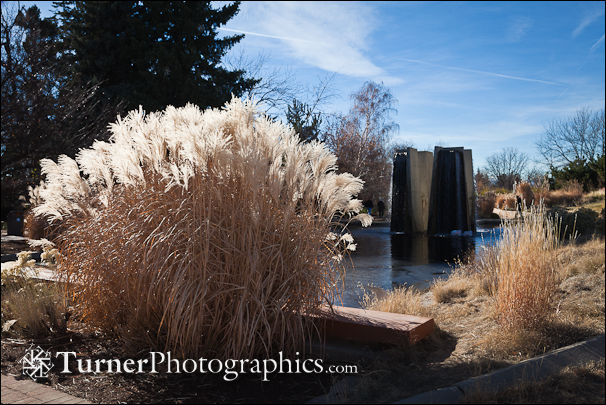Sunshine on My Shoulders

When you were first starting to take pictures you probably learned to put the sun behind you. At least that’s what I was taught way back in the ’60s. The results were predictably poor: harsh shadows, squinting little sisters, ugly light, and washed out colors. As you learned more and developed your skills you maybe decided to stay out of the sun altogether. Your dermatologist was delighted and you created nice soft landscapes and flattering snapshots of Aunt Jenny.
But sometimes you’re visiting someplace special and just can’t avoid photographing under midday sun. That’s what I experienced over Thanksgiving weekend on a visit to the delightful Denver Botanic Gardens. I’d never been there and was pleasantly surprised how nice the gardens looked during what has to be the most “off” of the off-seasons. Late November rarely looks good in a garden. Fall is fading and winter hasn’t quite arrived yet.
 It was a gloriously pleasant sunny with little wind. My family was with me, obliging my slow and contemplative movements around the garden, delaying lunch, and generally putting up with my photography. Nothing was blooming, yet the colors and textures of the garden were great.
It was a gloriously pleasant sunny with little wind. My family was with me, obliging my slow and contemplative movements around the garden, delaying lunch, and generally putting up with my photography. Nothing was blooming, yet the colors and textures of the garden were great.
So what’s my trick for photographing in the middle of the day, out in full sun?
In a word, backlight. I concentrated on photographing the grasses, which are the images I’m sharing here. Grasses of almost any type scream out to be photographed with sunlight streaming through their seed heads. Two of the photos here are of varieties of Maiden Grass, Miscanthus sinensis cultivars. The photo at the left is a combination of Mexican Feather Grass, Nasella tenuissima, and Little Bluestem, Schizachryium scoparium on a mound.
Another trick to use in full sun is to get your camera down low so the blue sky becomes the background. That provides a strong visual clue to your viewer that you were shooting on a nice day. The low angle helps to avoid distracting background elements, too. In the DBG I had to be careful to keep a couple of adjacent radio towers out of my sky, but it wasn’t too hard to select nice angles.
 Working with strong backlight like this photograph of Maiden Grass you have to be careful about exposure. With modern digital cameras you can take the lazy way and use auto exposure and then from trial and error adjust exposure compensation until you’ve avoided clipping the highlights. That’s a fancy term for washing out all the detail in the bright parts.
Working with strong backlight like this photograph of Maiden Grass you have to be careful about exposure. With modern digital cameras you can take the lazy way and use auto exposure and then from trial and error adjust exposure compensation until you’ve avoided clipping the highlights. That’s a fancy term for washing out all the detail in the bright parts.
The more precise technique is to make a spot meter reading on the highlights and then open up about a stop and a half so you hold detail. It won’t be possible to hold detail in both the brightest highlights and the darkest shadows at the same time. The brightness range is simply too much for either a digital sensor or slide film. I prefer to expose for the highlights. I used a little bit of the “fill light” adjustment in Adobe Lightroom to open the shadows in this photo.
Another thing to consider shooting against the sun is controlling lens flare. Some photographers these days seem to like including flare in their photos, but I think it just reduces the contrast and add weird greenish color casts. I always use my lens hood, and sometimes also end up shading the lens with my hand or my hat. Having my camera on a tripod makes it easier to do this since position of the shade is critical. It often has to be very close to the edge of the frame.
These images were made with my Canon 5D Mark II and the Canon 24-105 lens. That glass seems particularly prone to flare in strong backlight.


One really fine thing about shooting in November is full sun is not really full sun. Even at mid-day the light slants in. And when grasses are involved – Magic. Nice job
Saxon, you’re right. Mid-day sun in November in Denver is about 30° above the horizon. That’s the same as about 6 pm on June 23. One of the advantages of winter photography is sweet light all day long (except at home in the northwest where it may be dull and gray all day).